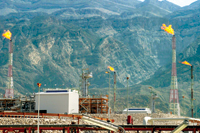
 ONGC ... exploring the possibility of deals with Iran
ONGC ... exploring the possibility of deals with Iran
INDIA and Iran have agreed to clear outstanding euro-dominated oil debts with payments in Indian rupees. The two sides have also made further steps in negotiations over the introduction of production-sharing contracts in Iran to replace the unattractive buyback scheme in order to attract Indian investors.
India and Iran seem to be interested in renewing their energy relationships at a time of tightened US sanctions against Iran.
Recent agreements will allow Iran to recover its oil payment debts from India, albeit in rupees and not in euros. Additionally, with a new oil contract scheme, Iran is seeking to incentivise Indian oil companies to invest in Iran’s sanctions-hit upstream sector.
For both India and Iran, closer energy-based relations make sense given Iran’s need for foreign investments and India’s need to diversify its energy supply sources. However, US sanctions and political pressure may remain an obstacle to the energy talks.
Iran has agreed that India will pay its euro-dominated oil debts pending since February 2013 in Indian rupees and accept as of now all Indian oil payments in the local currency, according to the Indian oil ministry.
Iran will now be able to recover the accumulated $1.5 billion of Indian oil debts, after euro payments via Turkey’s Halkbank came to a halt in February as a consequence of tighter US financial sanctions against Iran due to its controversial nuclear programme.
This follows an agreement between Iran and India in mid-2011 in which both sides decided to settle 45 per cent of India’s oil import bill in rupees and the remainder in euros. These payments were being routed through India’s state-owned UCO Bank.
In addition, Iran has renewed its offer to Indian oil companies extended earlier this year to agree on a changed contractual model for upstream exploration acreage. This would move from a fixed service contract model (a buyback scheme) to a production-sharing contract (PSC).
Iran’s buyback formula was introduced by the government as a way of circumventing a constitutional restriction on PSCs. Under the buyback scheme, investors were repaid from the proceeds of a finished project at a previously agreed rate of return (Eni, Shell, and Statoil all had buybacks).
With a revised version of the PSC-like hydrocarbon contracts, Iran hopes it can incentivise Indian companies (and possibly other foreign oil companies – perhaps Russian) to invest in Iran’s oil and gas sector; after all foreign oil companies prefer to hold equity shares and have longer involvement in upstream projects.
Ahmad Qalebani, head of the National Iranian Oil Company, has confirmed that Iran is reportedly preparing a modified oil contract formula to improve the terms of its buyback contracts, according to Iranian media reports. According to Qalebani, the Iranian buyback contracts are likely to be replaced by this yet-to-be-defined new form of PSC.
Recent developments regarding the contractual changes in Iran’s oil industry back up announcements made by Iranian officials in January and May.
 |
HPCL ... importing Iranian crude |
The Indian and Iranian governments agreed in May, for example, to discuss outstanding issues related to the development of the Farzad B gas field in the Farsi Block offshore Iran.
Iran and India announced a memorandum of understanding on developing the Farsi Block in 2002 – which contains the Binaloud oilfield and the large Farzad B gas field – but Indian state-owned oil company ONGC has not yet signed a contract with Iran for the proposed $5-billion oil and gas development.
Even after Iran issued an ultimatum in February 2012 asking ONGC to decide whether it would develop Farzad B, ONGC missed the November 2012 deadline, citing the risks involved in investing in Iran and the unattractive buyback contracts in place.
With Indian investment, Iran expects to be able to explore and develop Farzad B’s reserves, which are estimated at 12.5 trillion cubic feet (tcf) of natural gas and 212 million barrels of condensate, in the hope of producing a potential 1.1 billion cubic feet per day (bcfd) of gas in the first development phase.
Therefore, observers are curious to see whether Iran’s offer of PSCs will change ONGC’s investment decision and bring the company back to Iran to develop Farzad B.
Furthermore, the Indian government seems to have overcome its previous objection to Indian refiners importing Iranian crude. India’s oil minister Veerappa Moily and his former Iranian counterpart Rostam Qasemi met in New Delhi in May to discuss the issue of insurance coverage for cargoes as well as reinsurance for Indian refineries processing Iranian crude.
Indeed, Mangalore Refinery and Petrochemicals (MRPL) and Hindustan Petroleum Corporation Ltd. (HCPL) have agreed to import Iranian crude. This is relevant at both refiners stopped imports from Iran in April because of a lack of local insurance coverage for processing Iranian crude. In April, the Indian government proposed setting up an INR20-billion ($346-million) insurance fund to provide cover to domestic refineries, including MRPL and HCPL.
The insurance pool was intended to combine contributions from Indian insurance companies and the country’s oil industry. However, it remains unclear how much sovereign insurance coverage the Indian government is willing to contribute in case state-owned and private Indian insurers enforce an exclusion clause in their insurance policies denying cover to Indian refiners processing Iranian crude.
Thus far, India’s largest state-owned insurer GIC has reportedly offered up to INR5 billion ($84 million) reinsurance coverage to MRPL. However, following the renewal of the US sanctions waiver in June, Indian refiners seem to be more confident about resuming Iranian crude imports. Meanwhile, privately owned Indian refinery Essar Oil continued importing Iranian crude in May, buying two cargoes.
Overall Iranian oil imports have plummeted to 13.3 million tonnes of oil for the fiscal year ending on 31 March, down from 18 million tonnes in the previous fiscal year, according to Indian officials.
According to government figures, India cut its imports of Iranian oil by 26.5 per cent year-on-year in the fiscal year that ended on 31 March, while Indian oil imports from Iran in April dropped to 56.6 per cent from a year ago.
Iran’s hydrocarbons sector has been severely affected by Western sanctions and is facing underinvestment and a lack of technological capacity. It remains to be seen whether Indian companies will agree to invest into Iran’s oil and gas sector under the new contract scheme, which is likely to be more profitable than the existing Iranian buyback contracts.
Thus far, India’s ONGC Videsh Ltd (OVL), the country’s largest state-owned oil investor abroad, and another state-owned company, Oil India Ltd (OIL), have declined to comment on the contract talks between India and Iran. However, increasingly supportive comments from officials in both countries indicate that India will seek to continue negotiations with Iran on this matter.
Some industry sources indicate that an Iranian decision regarding contractual deals with India could be reached within the next six to eight months. From a political and economic point of view, both countries could sell an agreement over an oil deal as a win-win situation domestically.
As already mentioned, Iran needs foreign investments in its oil and gas sector as the long-running sanctions have taken their toll. India needs to address its energy supply security to meet rising demand at home.
Enabling Indian companies to invest in lucrative oil deals in hydrocarbons-rich Iran could add an additional source of hydrocarbons supply to India’s economy and increase the exposure of its internationally operating oil companies.
However, the current sanctions regime only allows investments of up to $20 million per year in Iran. India is therefore likely to face substantial political pressure from the US over any energy-related rapprochement with Iran – and US waivers for Iranian oil import sanctions may be called into question.
























































































